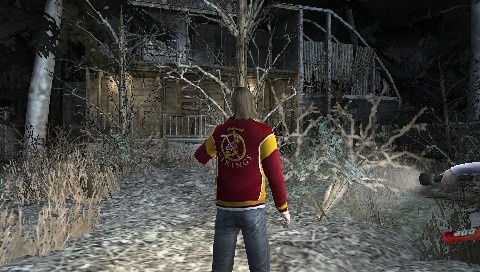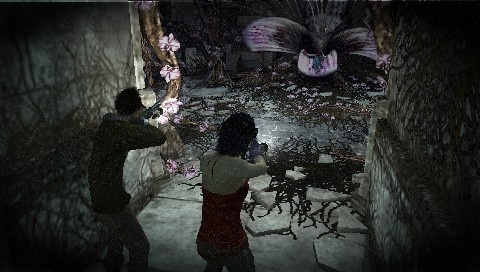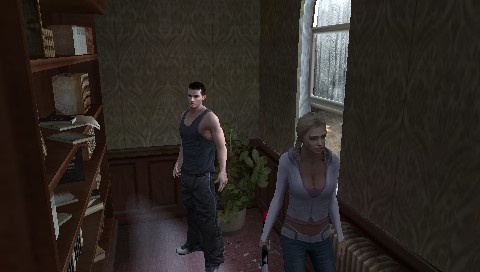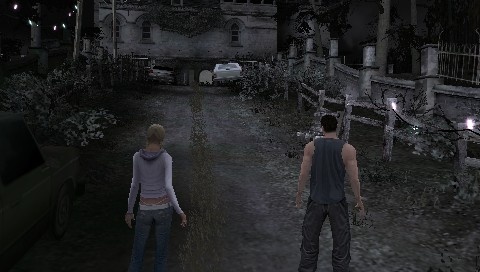Classic survival horror games such as Resident Evil and Silent Hill were never noted for their outstanding combat or truly dynamic gameplay. Their power rested on the fear generated by the constant struggle to stay alive in a world where you're outnumbered and outgunned and being chased by things with way too many teeth and arms in all the wrong places. That's the bitter irony of Obscure: The Aftermath, a good PSP port of a Wii game that was itself a sequel to a marginally popular Resident Evil knockoff released back in 2004. Much about the game is a well-done throwback to those early survival horror days. Unfortunately, for all the game's virtues, it never manages to rise above a decent homage because it fails in the one area that those games excelled in: creating a sense of atmospheric dread and genuine scares.

The original Obscure followed the harrowing adventures of a group of high school students battling biological monstrosities and their own teachers as a deadly evil overtook a quiet suburban school. Obscure: The Aftermath picks up the story as a few of the survivors of the original game, now college students, must deal with a strange black flower spreading like kudzu all over their campus. Students are grinding the flower up and making tea out of it in order to get high. This naturally leads to all sorts of unpleasant things, and on the night of a big frat party, homicidal jocks, big lumpy meat monsters, and a fascinating collection of ugly Lovecraftian beasties are looking to chow down on your dysfunctional crew of erstwhile academics.
If you've ever played a survival horror game, you'll be right at home in Obscure: The Aftermath. You control one of six characters trying to survive, and you'll have an AI companion in tow. Sometimes you'll get to choose which characters to use; other times the pairing will be dictated by the storyline. In each case, movement and combat are relatively slow and straightforward: the right shoulder button is used to go into fighting mode, and the left is used to switch weapons and use items. It's a good, if not completely elegant, system and is certainly serviceable enough that you'll never feel like you're fighting the controls rather than the monsters. What really helps is that the inventory screens and combat controls have clearly been designed with the wide screen of the PSP and the positions of the unit's physical controls in mind.
The major problem with the game's combat is actually the AI companion. Because you'll never be fighting alone, decent companion AI would seem to be a must for this game. Unfortunately, the companions you get all seem to have a death wish, because they frequently go rushing in at the biggest monster and flail away in melee, often getting in the way of your own efforts to kill the thing and taking damage from unintended friendly fire. The camera doesn't help matters much, since it frequently picks really bad angles to view the action from. Fortunately, the camera is somewhat under your control via the directional pad--at least until the game itself unexpectedly wrests control out of your hands at what's often the worst time. It's not bad enough to ruin the game outright and can be overcome with some careful maneuvering on your part. It's just an annoyance the game could have avoided merely by using a static rather than a free-floating third-person camera and toning down your companion's bloodlust.

The good news is that there are two ways to overcome the poor companion AI. The first is by switching between the two currently active characters, a one-button option available at any time that works well. This option also plays a key role in using a character's special abilities. Each character has a different skill--such as being able to climb to high ledges, pushing heavy objects, or hacking electronics--that will need to be used to overcome the game's fairly simple but enjoyable puzzles. The only issue with this is that it is possible to run into annoying roadblocks when you select the wrong characters for a particular segment and are forced to backtrack to where the other four are hiding.
The second, much more enjoyable way is by bringing along a friend. Obscure: The Aftermath boasts a fun Co-Op mode that lets other players drop in and out of the game via ad hoc at will. The mode works quite well, though there is occasional slowdown when interacting with an object or accessing a menu. That minor difficulty is more than made up for by the sheer joy of not having to share the same screen with an AI companion (though characters must stay in the same room) as well as by having a companion with a functional brain who can use the right weapon when asked to and doesn't feel the need to constantly go rushing pell-mell into the mouth of madness.

In terms of presentation, Obscure: The Aftermath is a standout. Technically and artistically, the game looks great on the PSP. The areas show a surprising amount of detail given how little space there is to work with on the system's diminutive screen. As the settings get stranger and bloodier, their presentation becomes more effective, and if they never quite level up to truly frightening, a couple of images at least hit disturbing. The monsters and characters are all animated well, and the development team even went so far as to make each of the college students you'll control walk, move, and fight in a different manner. The game's visuals are matched and possibly exceeded by a stellar soundtrack provided by the Boston String Quartet and the Paris Children's Opera Choir. What little tension the game manages to generate is due mostly to the great music that conveys emotion in ways unmatched by the gameplay.
Unfortunately, all the great presentation in the world means nothing without something enjoyable to present, and this is where Obscure: The Aftermath ultimately falls down. The problem is that the game tries to have it both ways. The storyline and characters are right out of teen-slasher-movie central casting, and there isn't a single character or line of dialogue that's not a walking, talking horror-movie cliche. Given how uniformly horrible the dialogue is and how amazingly bad the voice-overs are, there is a possibility that the developers realized this and tried to play it for laughs, but if so, they failed. The words spoken aren't bad enough to work their way around to cheesy good fun; they're just bad. The characters aren't broadly parodic enough to be enjoyable; they're just whining, self-centered losers who seem to react in horribly inappropriate ways to circumstances that would turn most people into gibbering maniacs.
The game's emphasis on co-op and genre dialogue also short-circuits one of the staples of the survival horror genre: the pervasive feeling of being alone and outnumbered. Having another person with you to talk to while facing the hounds of hell offers a touchstone of normality and human contact that a genre that thrives on alienation and fear simply can't afford. The gameplay design factors into this as well since weapons and ammunition drops are plentiful enough that the perceived level of danger decreases significantly. In the end, the game's poor characterization and plotting along with abortive attempts at humor turn what might have been a truly chilling experience into more of a subpar B-movie monster fest.

It's interesting how intangibles can damage an experience. From a technical point of view, there's much to praise in Obscure: The Aftermath. The game is great looking, and the soundtrack is stellar. The game controls well, and if combat gets annoying occasionally because of subpar AI, it isn't anything that can't be worked around or, better yet, cured through Co-Op mode. The problem is that this is a game that's supposed to make you laugh and make you afraid. Annoying characters you don't care about and abominable dialogue prevent the former, and it's that ham-fisted attempt at humor that dooms the latter. The result is a game that's not awful but is a mere shadow of what it might have been.